Keeping your hedge trimmer blades clean is essential to ensure that they perform optimally and last longer. It’s important to regularly clean the blades of any built-up dirt, debris, or sap from plants. This will help keep them sharp and free of rust. Cleaning the blades can be done in a few simple steps with items you likely already have around your home. With just a few minutes of effort, you can easily maintain your hedge trimmer for years to come!
Table of Contents
Why This Is Essential To Clean The Blades
Cleaning the blades of your hedge trimmer is essential to ensure that they are able to perform at their best and last longer. This is because dirt, debris, or sap can build up on the blades over time, resulting in a duller cutting edge and increasing the risk of rust. Keeping them clean will prevent this buildup from happening and help them to stay sharp for longer. It can also be beneficial to remove any rust that may have formed on the blades, as this can reduce their performance and lifespan. Regular cleaning will ensure that your hedge trimmer is always able to perform its best! Additionally, it will help you to identify any damage or wear that may need to be addressed. By regularly cleaning the blades, you can ensure that your hedge trimmer is well-maintained and ready for use when needed. [1]
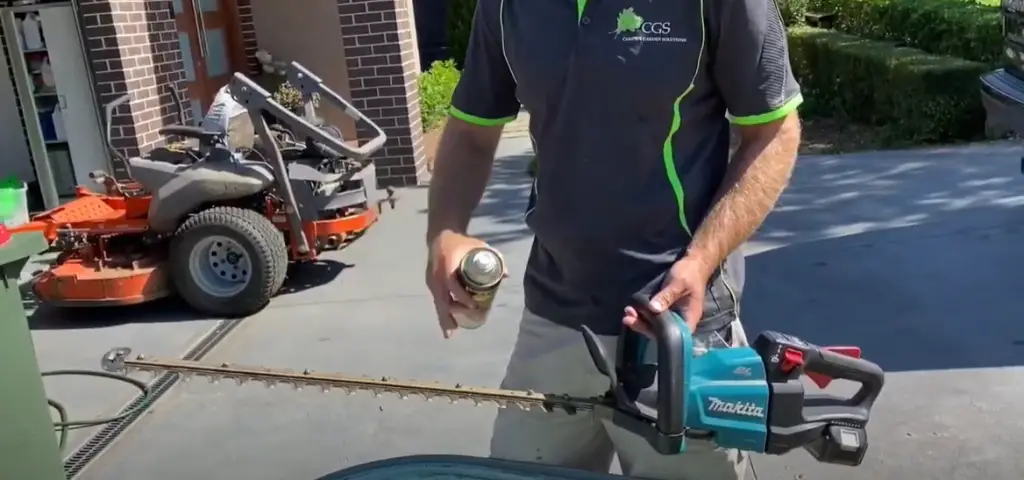
How To Clean The Blades Properly And Safely
The first step in cleaning the hedge trimmer blades is disassembly. Be sure to turn off the power and unplug the machine before beginning. Carefully remove any debris from between the blades, then take off both of the blade guards. Be sure to wear protective gloves during this process as there may be sharp edges or jagged points on the blade.
Next, use a damp cloth or paper towel to carefully wipe away any dirt, grass clippings, sap, or other debris from the blades. This step is important as any debris left on the blades can affect their ability to cut effectively. It may also help to apply a light lubricant such as WD-40 or vegetable oil to the blades during this step.
When finished, store your hedge trimmer in a dry and secure location to ensure it stays clean and out of the reach of children. Regularly cleaning and maintaining your hedge trimmer blades will help keep them sharp and functioning properly for years to come. [2]
Clean The Blades With Soap & Water
- Unplug your hedge trimmer and make sure that it is turned off before attempting any cleaning.
- Use a brush to get rid of the larger pieces of dirt and debris from the blades, then use a cloth or vacuum cleaner to remove even more dirt.
- Mix some dish soap with warm water in a bucket and dip the blades into the mixture, then use a brush to scrub off any remaining dirt.
- Once you have removed all visible dirt and debris, rinse the blades with clean water to remove any soap residue.
- Dry the blades thoroughly with a soft cloth and inspect them for signs of rust or wear before using your hedge trimmer.
- To further protect your blades from rust and wear, lubricate them with a light oil or cooking spray before putting your hedge trimmer away. This will help to ensure that your blades stay sharp and in good condition for future use.
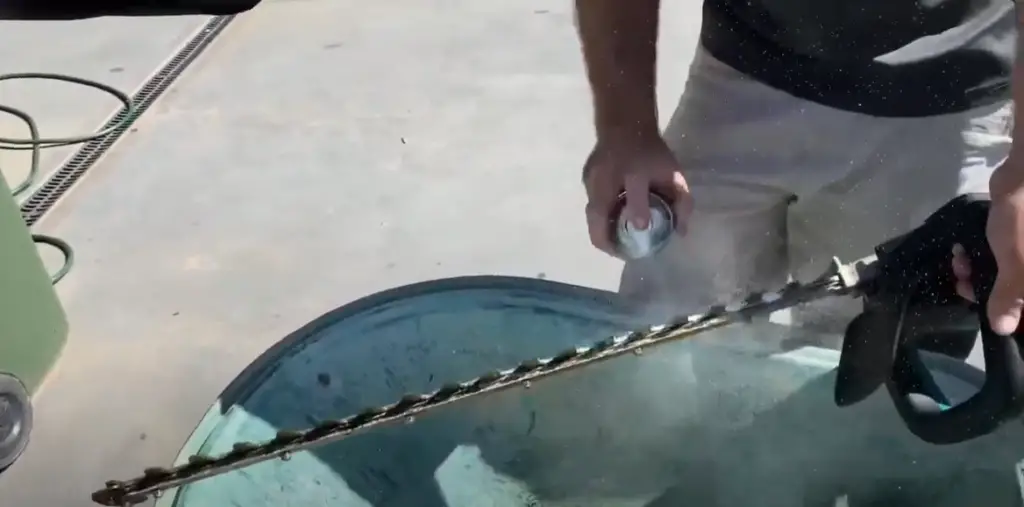
Cleaning Blades With Alcohol Or Kerosene
Cleaning the blades of your hedge trimmer with alcohol or kerosene is a safe and effective way to remove any built up dirt, debris and sap from the blades. Begin by turning off the power and unplugging the trimmer. Put on safety glasses, gloves and protective clothing to protect yourself from flying particles as you clean the blades.
Using a clean cloth, brush or paper towel, dampen the material with either alcohol or kerosene and then gently scrub away any caked on dirt or debris off of the blades. Take extra care to ensure that all surfaces are well scrubbed and no accumulated dirt remains on the blade. Once finished wiping down each blade, wipe off excess liquid with a clean cloth.
If there are still stubborn areas of dirt or sap on the blades, use an old toothbrush to scrub away any remaining debris. Once finished, dry off the blades with a cloth and reattach the blade guards before plugging in and powering up your trimmer again. With proper maintenance and cleaning, your hedge trimmer should remain sharp and functional for years to come. [3]
Using Specialist Cleaners
Specialist blade cleaners can be used to clean and lubricate hedge trimmer blades. These cleaners are specially formulated to remove dirt, grime and sap while providing a protective film that helps keep the blades sharp. Before applying specialist cleaner, make sure to unplug the trimmer or remove the battery if it is cordless. Then, use a cloth to wipe the blades clean. Apply the cleaner liberally and let it soak in for a few minutes before wiping off any excess with a dry cloth. Once you have applied the cleaner, plug in or re-install the battery and test your trimmer on a small piece of scrap material. If everything looks good, you can safely resume cutting.
It is important to remember that specialist cleaners should be applied regularly in order to keep your blades clean and lubricated. If you do not use a cleaner, the dirt, sap and grime can quickly accumulate on the blade and cause it to become dull or even rust. In addition, it can also lead to poor performance and a decrease in the life of your trimmer. Therefore, it is important to keep the blades clean and lubricated with a specialist cleaner for optimal performance.
Lubricating The Hedge Trimmer Blades With Wd-40
Once you have cleaned the exterior of your hedge trimmer blades, it is important to lubricate them. Lubricating helps the blades move freely and reduces friction, which can lead to wear and tear on the blades. To lubricate your hedge trimmer blades, use a high-quality product like WD-40 Specialist Lawn & Garden Tool Cleaner & Lubricant.
Repeat this lubrication process every few months or whenever you notice that the blades become dry and start to squeak when cutting through hedges. This will help keep your hedge trimmer running smoothly for years to come. [4]
Tips Hedge Trimmer Blade Cleaning
- Unplug the hedge trimmer from any power source and place it on a flat surface.
- Use a soft brush to remove dirt, debris and excess material from the blades of the trimmer. For stubborn dirt or residue, use a damp cloth with warm soapy water.
- If needed, you can also use a light weight oil to loosen stubborn material from the blades.
- Inspect the blades for any damage or wear and tear that may have occurred over time and replace if necessary before continuing.
- Using a lubricant specifically designed for your hedge trimmer, apply an even coating of oil to the blades of the trimmer. This will help reduce friction and keep the blades running smoother for longer periods of time.
- Once all debris has been removed and the blades have been oiled, put a protective cover on the hedge trimmer to prevent dust and dirt from re-accumulating on the blades.
- To maximize performance, sharpen the blades of your hedge trimmer at least once a year. This can be done manually using a sharpening stone or with an electric grinder or Dremel tool.
These steps should help you keep your hedge trimmer blades clean and in good working order for many years to come.
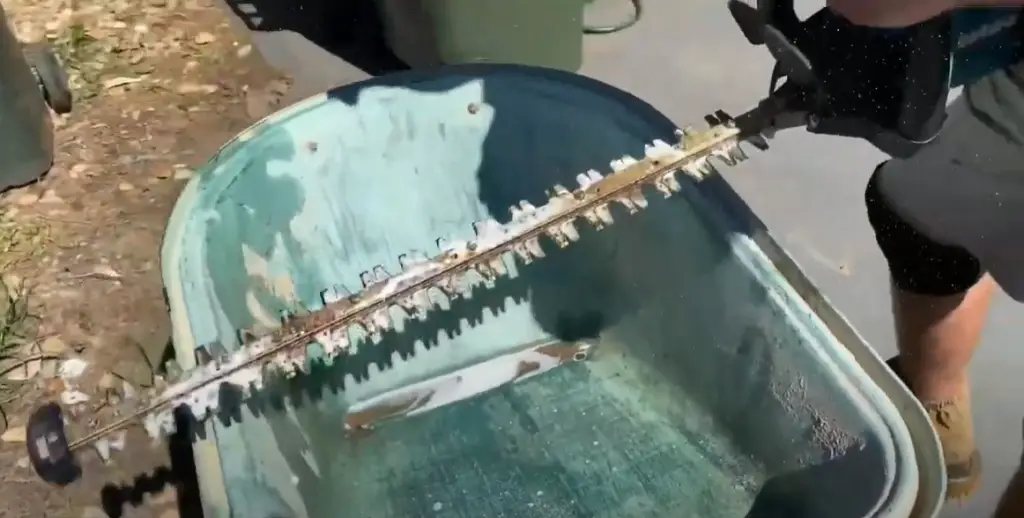
FAQ
What is the best cleaner for hedge trimmer blades?
The best cleaner for hedge trimmer blades is a simple solution of soap and water. Mix together a few drops of mild dish soap with warm water in a bowl and use a soft-bristled brush to scrub the blades. If there is extra dirt or debris on the blade, you can also use an old toothbrush to gently remove it. Be sure to rinse the blades off with clean water afterwards.
Can I use WD-40 on hedge trimmer blades?
No. While WD-40 is an excellent lubricant and rust preventative, it should not be used on hedge trimmer blades. The petroleum base in WD-40 can degrade the rubber components in your hedge trimmer, which could lead to premature wear or even failure of the unit. Additionally, WD-40 can build up over time and leave a residue that can be difficult to remove. It’s best to stick with the manufacturer-recommended cleaning and lubricating products for hedge trimmer blades.
How do you remove resin from a hedge trimmer?
Removing resin from a hedge trimmer is an important step when it comes to keeping your hedge trimmer in good condition. Resin can build up on the blade over time and can cause the blades to become dull or even break. Fortunately, there are several methods you can use to remove resin from a hedge trimmer.
How do you clean and sharpen hedge trimmer blades?
Cleaning and sharpening the blades of your hedge trimmer will help it perform better and last longer. To clean the blades, start by unplugging the trimmer from any power source and lay it down on a clean, flat surface. Gently brush away any dirt or debris that has built up on the blade with a soft brush.
Next, use a damp cloth or sponge to clean the blade of any remaining dirt and debris. Make sure to wipe off any excess moisture with a dry cloth and lay the trimmer back on its side so it is completely dry before plugging it into power again.
To sharpen your hedge trimmer blades, use a metal file to remove any burrs and shape the blade back into its proper shape. Make sure to move the file in an even motion along the entire length of the blade to ensure that it is sharpened evenly. Once finished, wipe off any filings from the blades with a damp cloth and dry with a clean cloth before putting your hedge trimmer back together. Make sure to sharpen your hedge trimmer blades regularly to keep it in tip-top shape and working properly.
For more difficult cleaning jobs, consider using a specialty blade cleaner formulated for the specific material used with your hedge trimmer. These cleaners are designed to cut through tough dirt and grime buildup without damaging the blades.
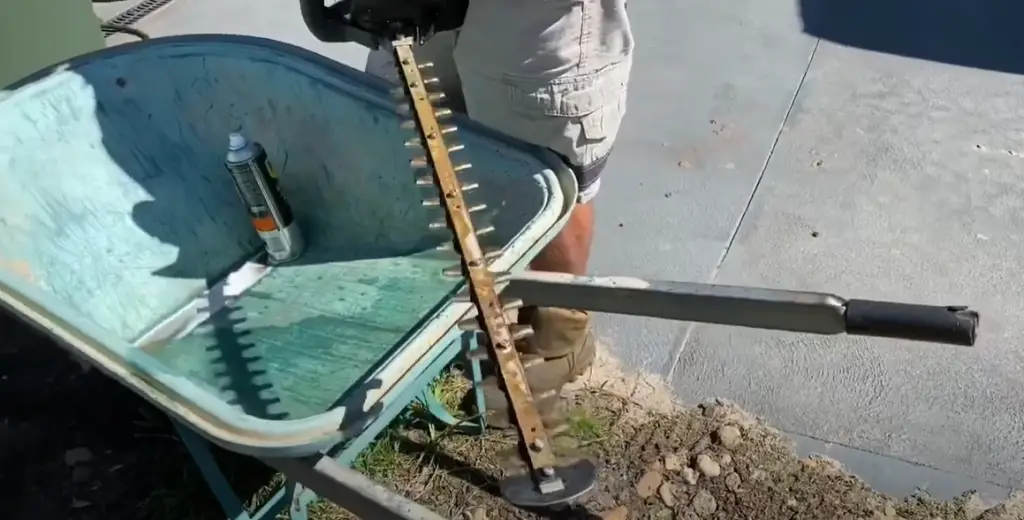
Should hedge trimmer blades be oiled?
Hedge trimmer blades should not be oiled. Oil can build up and make the blades stick together, which will cause the hedge trimmer to become less efficient and potentially dangerous. Instead of oiling the blades, it is recommended to sharpen them regularly with a file or sharpening stone for best performance. Additionally, keeping an eye out for any cracks or chips in the blades can help reduce the risk of injury during use. Hedge trimmer blades should also be wiped down with a damp cloth after each use to remove build-up and debris. This will ensure that they remain sharp and in peak condition while preventing rusting over time.
How do you clean and lubricate a hedge trimmer?
First, unplug the hedge trimmer and let it cool down before beginning. Then, take a clean cloth and wipe away any dirt or debris from the blades. Be sure to use caution when cleaning near the blade edges. Once the blades are free of dirt and debris, you can apply some lubricant to them.
Use a high-quality lubricant specifically made for hedge trimmers. Apply the lubricant to the blade edges, not to the inside of the blades. Once you have applied the lubricant, reassemble your hedge trimmer and plug it in. After use, be sure to wipe down your hedge trimmer with a clean cloth and store it in a dry area to prevent rusting. This will help keep your hedge trimmer in top condition.
How do I keep my hedge trimmer blades sharp?
Keeping your hedge trimmer blades sharp is an important part of proper maintenance. A dull blade will not only make trimming your hedges more difficult, but it can also cause damage to the plants you’re trying to shape. Fortunately, there are a few simple steps you can take to help ensure that your blades remain in top condition. First, make sure to clean your hedge trimmer blades after each use. This will help prevent rust and other debris from building up on the blades and dulling them over time. Start by wiping down the blade with a damp cloth or rag to remove any dirt or sap that may have accumulated during trimming. For tougher buildup, use a mild detergent or oil to loosen the debris before wiping it away.
Can you clean clipper blades with soap and water?
Yes, you can clean clipper blades with soap and water. Start by making sure the trimmer blades are unplugged from the power source and cool to the touch before beginning any cleaning process. Using a stiff brush, scrub the blades thoroughly with a mild detergent. Rinse off the soapy residue with warm running water and pat dry with a soft cloth. To prevent the blades from rusting, lightly oil them after drying. Be sure to take extra caution when cleaning and handling the blades to avoid any injuries.
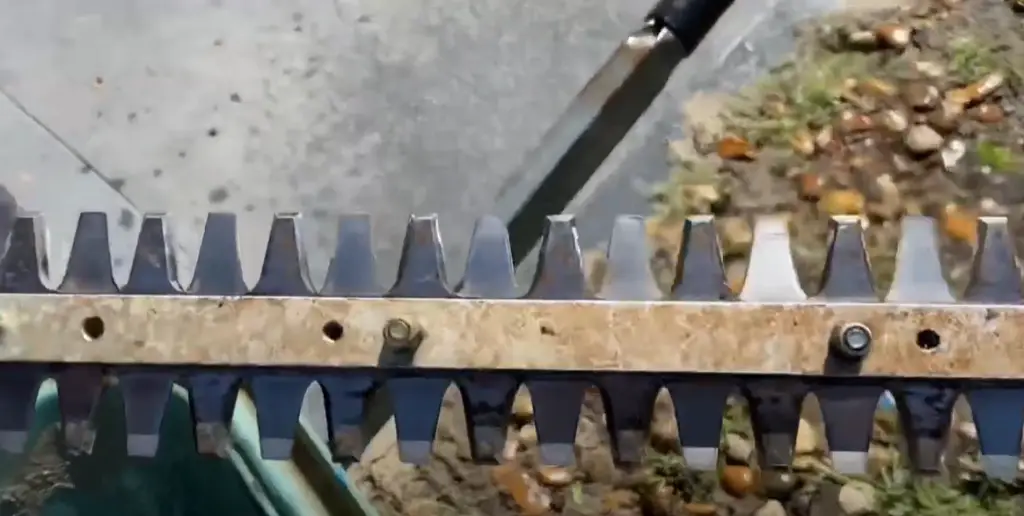
When should you not use WD-40?
While WD-40 can be used for a variety of tasks, it is not recommended to use it for cleaning hedge trimmer blades. WD-40 is primarily composed of petroleum and mineral oils which does not make it suitable for removing dirt, debris or other materials from the blades. Furthermore, over time the lubrication from WD-40 can actually attract dirt and debris to the blades, making it difficult to get them clean. Also, as mentioned previously in this article, WD-40 is not designed for removing rust or corrosion – which can weaken the metal of the hedge trimmer blades over time. For these reasons, it is best to avoid using WD-40 when cleaning your hedge trimmer blades.
Useful Video: How to clean hedge trimmer blades
Conclusion
After cleaning your hedge trimmer blades, check them for any damage or wear and tear. If needed, sharpen the blades as necessary before continuing with trimming. Be sure to always wear protective gear when cleaning and sharpening hedge trimmer blades, such as safety goggles and gloves, to ensure your safety. With proper maintenance of your hedge trimmer blades, you’ll be able to keep your hedges looking neat and tidy all year long and enjoy the outdoor beauty it brings to your home.
References:
- https://www.gardentoolbox.co.uk/news/how-to-sharpen-and-clean-electric-hedge-trimmer-blades/
- https://www.husqvarna.com/au/learn-and-discover/how-to-maintain-your-hedge-trimmer/
- https://homegardenscare.com/how-to-clean-hedge-trimmer-blades/
- https://wd40.africa/garden/how-to-clean-hedge-trimmers-properly-and-safely

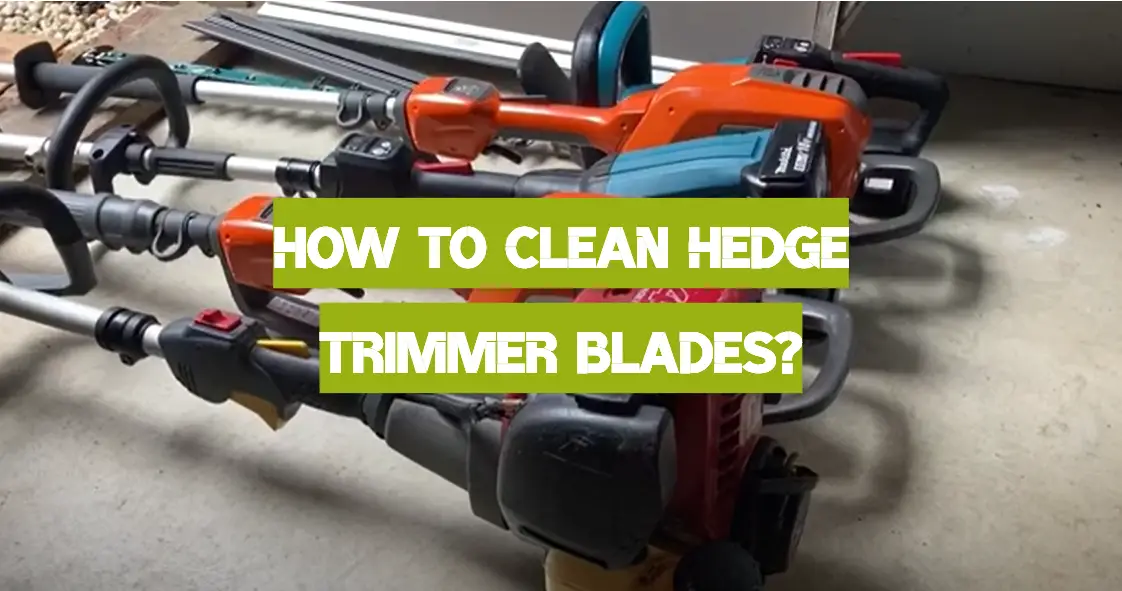





Leave a Reply